 |
 |
 |
 |
 |
 |
 |
 |
 |
 |
 |
 |
|
Home
|
Join Club
|
Book Reviews
|
Famous Members
|
Characters
|
Radio
|
Genealogy
|
Biography
|
Harper Lee
|
Clippings
|
Email Me
|
Search
|
T0 Kill a Mockingbird
This is a two-sided card Harper Lee sent me stating her favorite childhood books were Seckatary Hawkins The Gray Ghost and Stoner's Boy.
As you can read in her below copied letter, Harper asked me to limit mention of her on the website; but later agreed it would be OK to share this and other letters with you F&S Club members"
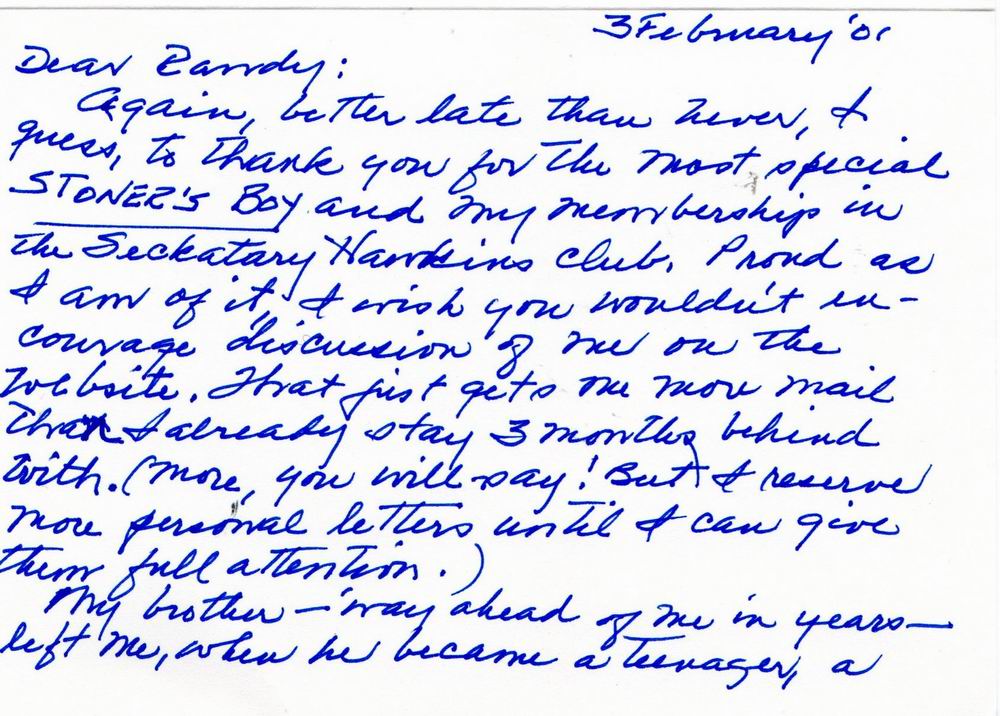
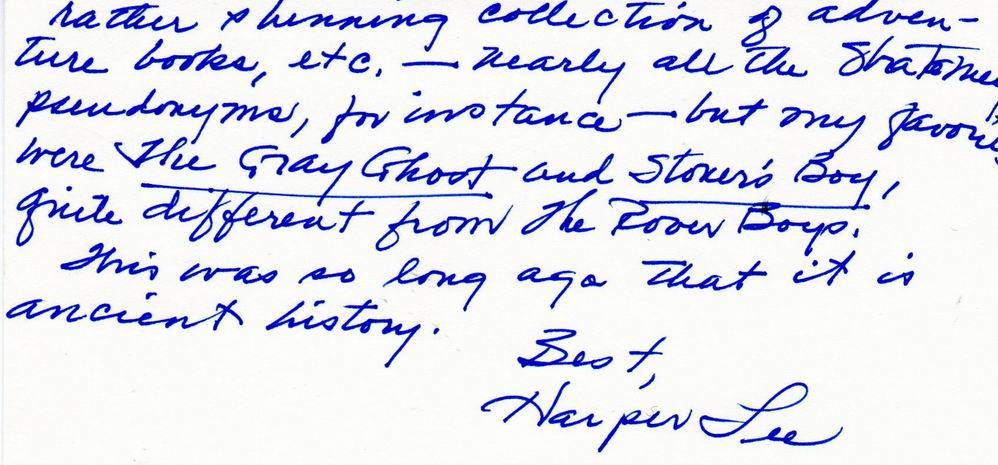
And this is the first edition book Harper Lee signed and sent to grandpa.

Below are the final pages of to Kill A Mockingbird quoting Seckatary Hawkins The Gray Ghost and Stoner's Boy
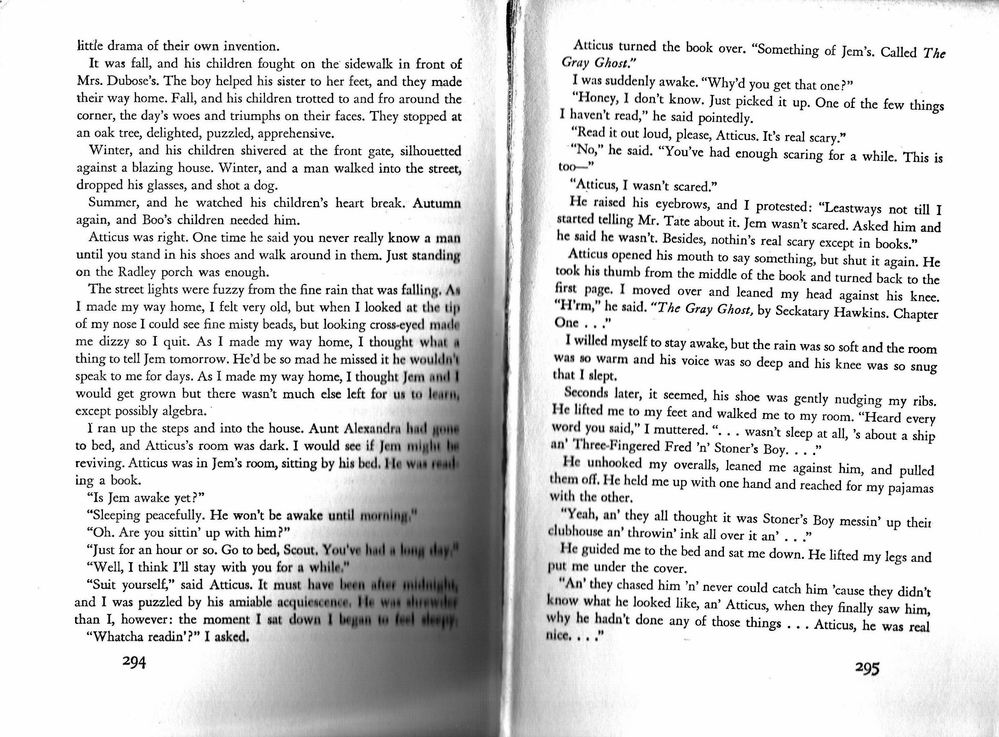
.jpg)
Harper Lee's brother Edwin started the Seckatary Hawkins book reading adventure in the Lee household. This is a Gray Ghost book Harper signed for grandpa:
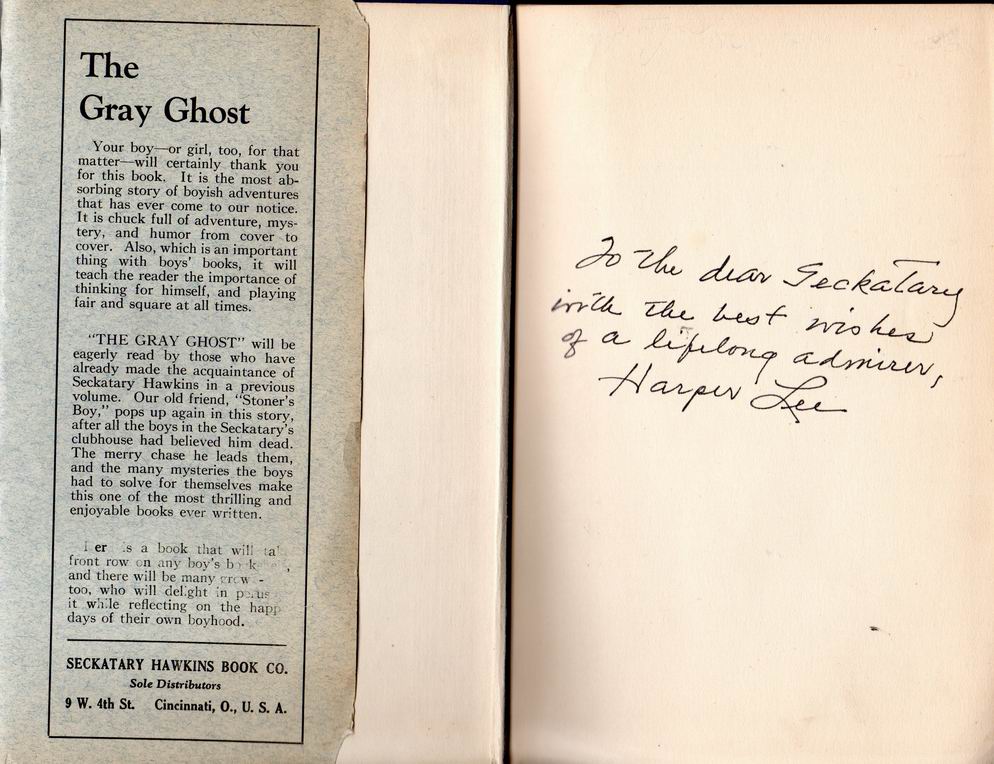
I asked for the original Stoner's Boy book she read as a child too, but she could not find it; so I sent her a new one, which she signed and sent back to me. I sent her a new replacement, of course.
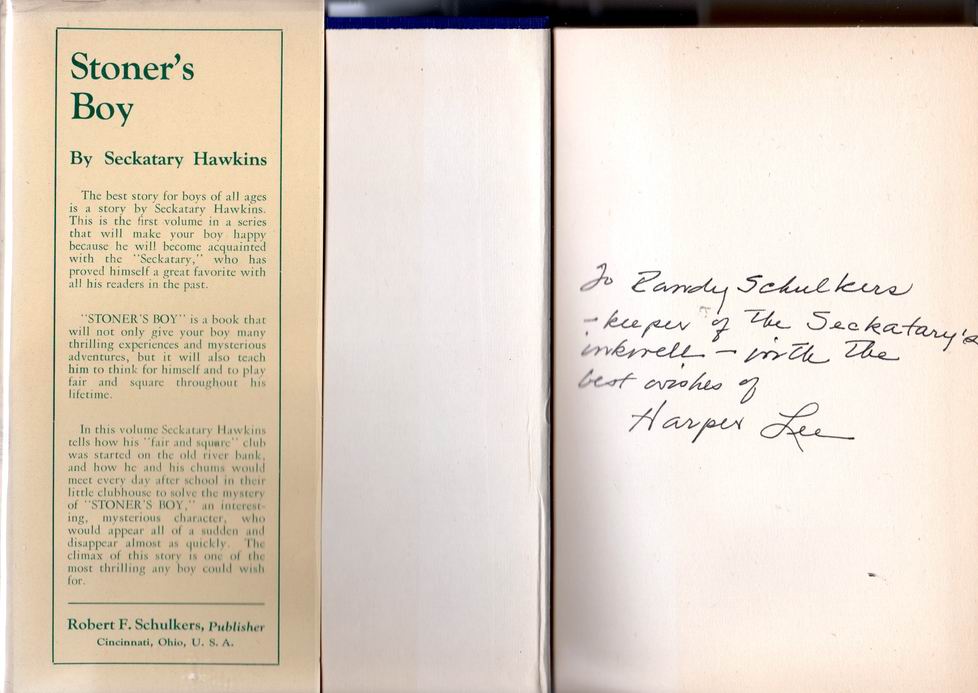
Harper reported to me in 2009, "Both Seckatary books occupy prominent spots on my bookshelves, each "protected" by one of the Seckatary bookend statues."
A 7/22/2015 article about Harper Lee and Seckatary Hawkins written by the Wall Street Journal appeared online.
Copy of that article appears below:
Meet the Children's Book Author Loved by Harper Lee: Seckatary Hawkins
Robert Schulkers aka Seckatary Hawkins. Photo courtesy of Randy Schulkers

Readers who have bought more than 1 million copies of Harper Lee's new novel Go Set a Watchman are also returning to the author's debut novel "To Kill a Mockingbird," a book they may have last read in junior high school.
For some, a second reading brings unexpected insights. Here's a literary nugget that might otherwise be overlooked
At the end of Mockingbird, Atticus Finch is reading to his daughter Scout from The Gray Ghost, a book written by one Seckatary Hawkins.
It turns out that Seckatary Hawkins was the pseudonym for Robert F. Schulkers, who published 11 children's books between 1921 and 1932 that had initially been serialized in weekly newspapers.
A website operated by the late Mr. Schulkers grandson Randy Schulkers notes that the Seckatary Hawkins books Harper Lee read when she was a young girl were Stoner's Boy and The Gray Ghost, both of which belonged to her older brother, Edwin. (Efforts to contact Ms. Lee via her attorney were unsuccessful.)
In the material below, Randy Schulkers discusses via email his grandfather and how his work and that of Harper Lee eventually intersected in such a dramatic way:
My grandfather wrote many motivating childrens stories and influenced millions of boys and girls from 1918 to 1949 in newspaper serials, radio shows, comic strips, and real live books. As proof of the effectiveness of Grandpa's moral lessons is the inclusion of and credit given to his stories by a Pulitzer prize-winning author who grew up reading her brother's copies of the books.
The last two pages of Harper Lee's novel To Kill a Mockingbird are about Grandpa's stories and values learned. Right now, you are perhaps thinking back as so many people who have read Mockingbird years ago do about the last two pages of that book. The words Seckatary Hawkins and Stoner's Boy and The Gray Ghost may not even have registered as you finished the wonderful novel Harper wrote, but it is there two pages of it.
An illustration of the Gray Ghost at Seckatary's desk dated July 16, 1922. Courtesy of Randy Schulkers

If Mockingbird is in your library, take a look right now or borrow one of your children's iPads to pull up the pages on the internet. I suppose that many people think Seckatary Hawkins was an imaginary author of a set of books which Harper created to illustrate the moral of her magnificent story. It was very kind of Harper to give such detailed mention, and credit to Grandpa's stories. Harper also chose to make mention of Seckatary Hawkins in her very rare public letter that spoke to her difficulty of trying to curl up with a computer versus the friendly pages of a real book printed in Oprah's magazine June 26, 2006.
If you care to find out more about these inspiring stories, I invite you to take a look online where I keep a website in Grandpa's honor. A number of fantastic, like-minded club members help me keep alive the Fair & Square club and values Grandpa set up nationwide in the early 1900s. The great majority of the current club members had Seckatary stories read to them as children by their parents who appreciated the good effect and pleasurable stories in these books.
Yours Fair & Square
Randy Schulkers
~A quitter never wins and a winner never quits~
The Gray Ghost book, and Stoner's Boy are frequently quoted references within the famous novel, To Kill a Mockingbird, published in 1960 by Seckatary Hawkins club member Harper Lee of Monroeville, Alabama. A particular quote from Stoner's Boy is the reference for the closing moral lesson that completes this famous novel.
References to the Seckatary Hawkins books and stories:
In chapter 7 of TKAM, Jem and Scout find a hiding place - a knot hole in a tree trunk on the edge of the Radley's yard. Later they realize that Arthur "Boo" Radley is actually showing his friendship by placing gifts for them in this hollow part of the tree. In the knot hole, they first find a ball of twine, then chewing gum, two Indian head pennies, an old watch, an old medal from a spelling contest, and two carved soap figures they consider is in their likenesses and other items. At first they are skeptical, but once they don't die from tasting the chewing gum, they decide to accept all the items as safe - and "our property". (ed. - As you may know, Harper Lee used a lot of her life experiences in her novel with slight modifications to fit the story line. There is a very similar hollowed out tree hiding place located on the road to Millville, in the 2/24/1918 Seckatary Hawkins newspaper sequel story entitled The Rejiment, where the boys hid all their "good stuff": a water pistol, pocket knife, slingshot, etc. The F&S Club boys often refer to the knothole as their "Chees-Hole". The Gray Ghost story begins a continuing reference, repeated in several other Seckatary stories, of holes in trees that are used as "secret post offices". Secret messages and other items are hidden away there for others to find).
One of our long-time Seckatary Hawkins F&S club members taught school for over 30 years, always reading from both books in class and illustrating for the children all correlations of Seckatary Hawkins to TKAM. Some of the observations from Teacher Peg Hoinowski are:
"At the end of the first chapter, when Scout, Jem & Dill are discussing Boo, Dill dares Jem to run up to touch the house. "I won't say you ran out on a dare an' I'll swap you The Gray Ghost if you just go up and touch the house.
At the end of the book, Atticus is reading The Gray Ghost. Scout starts telling the story to Atticus-----little by little Scout's narrative about the Gray Ghost melts into her description of Boo Radley: (TKAM Pages 254-255: ) 'Atticus was in Jem's room, sitting by his bed. He was reading a book...'Whatcha readin'?' I asked. Atticus turned the book over. 'Something of Jem's. Called The Gray Ghost. I was suddenly awake. 'Why'd you get that one?' 'Honey, I don't know. Just picked it up. One of the few things I haven't read', he said pointedly. 'Read it out loud, please, Atticus. It's real scary.' 'No', he said. 'You've had enough scaring for a while. This is too--' 'Atticus, I wasn't scared....Besides, nothin's real scary except in books.' ...He took his thumb from the middle of the book and turned back to the first page. I moved over and leaned my head against his knee. 'H'mm,' he said. 'The Gray Ghost, by Seckatary Hawkins. Chapter One...' I willed myself to stay awake, but the rain was so soft and the room was so warm and his voice was so deep and his knee was so snug that I slept....'Heard every word you said', I muttered. '...wasn't asleep at all. 's about a ship an' Three-Fingered Fred 'n' Stoner's Boy...' ...'Yeah, an' they all thought it was Stoner's Boy messin' up their clubhouse an' throwin' ink all over it an'...' ...'An' they chased him 'n' never could catch him 'cause they didn't know what he looked like, an' Atticus, when they finally saw him, why he hadn't done any of those things...Atticus, he was real nice...' His hands were under my chin, pulling up the cover, tucking it around me. 'Most people are, Scout, when you finally see them.' He turned out the light and went into Jem's room. He would be there all night, and he would be there when Jem waked up in the morning.'
There are more examples like that throughout the book.
One of the most touching parts of the book is when Scout walks Boo home that night. Instead of leading him by the hand as they had been doing, Scout makes Boo bend his arm for her to slip her hand into the crook of his arm. "He had to stoop a little to accommodate me, but if Miss Stephanie Crawford was watching from her upstairs window, she would see Arthur Radley escorting me down the sidewalk, as any gentleman would do." Scout gives Boo his dignity, as he deserves!
This shadowy figure (of Boo) is the only one with enough courage (other than Atticus) to stand up to the evil of Bob Ewell and that prejudice."
SOME OTHER INTERESTING FACTS:
RE: Scout's statements: The Gray Ghost story does contain the description of Seckatary's blotter with the ink bottle spilled by 3 fingered Fred who left a hand print in the ink, but no scattering of papers. But the term "messed up" , and the tearing up and scattering of books and papers around the club house does appear in the previous sequel book, Stoner's Boy, p51.
The Seckatary Hawkins books Harper Lee read when she was a young girl were Stoner's Boy and The Gray Ghost, both of which belonged to her older brother, Edwin.
Boo Radley finally comes out on Halloween when children say, "Boo" and dress up like ghosts."
School teachers often ask students - "Do you know why Harper Lee chose a Seckatary Hawkins story to illustrate this ending?" A few years ago, an interesting conclusion was made by school children studying TKAM and The Gray Ghost connection: "The Gray Ghost book suggests that when we die, there will no longer be race difficulties because we will not be white or black or red - we will all just be gray" (All of us the same).
 The To Kill a Mockingbird Movie
The To Kill a Mockingbird Movie
The only mention of Seckatary Hawkins in the movie version was when the visiting boy, Dill bets a "Gray Ghost" against two Tom Swift's, in a rather different circumstance. This appears in Chapter one of the book, but seems a little later in the movie version. Jem's touch of the Radley house is also different, using Scout in an old tire that rolls to the Radley porch steps. After saving Scout, Jem runs up and touches the house. This movie editing omission is an unfortunate loss to the viewer since the ending of the movie makes no mention of the moral lesson of Seckatary's Gray Ghost and Stoner's Boy books. If one just sees the movie but does not read the To kill a Mockingbird book, they miss the final moral impact that the Seckatary reference affords.
A good reference site for Harper Lee:
http://www.chebucto.ns.ca/culture/mockingbird/
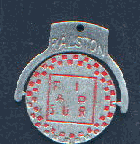 Seckatary spinner - reads Fair & Square when spinning.
Seckatary spinner - reads Fair & Square when spinning.
DID YOU KNOW?
*There were Seckatary Hawkins clubs with several million members reported during the radio broadcasts from the Chicago Merchandise Mart in 1929-30. Midwest newspapers ran the weekly stories and comic strips as late as 1954. There were also comic books, board games, club pins / pennants / coins / spinners / bookends, etc
*There is citation of the Seckatary Hawkins stories, Gray Ghost book, and is the quoted reference of the closing moral lesson in the famous novel, "To Kill a Mockingbird", written and published in 1960 by Seckatary Hawkins club member Harper Lee of Monroeville, Alabama.
Email me  Copyright © 1921.22.25.26.30.32.48.53
Copyright © 1921.22.25.26.30.32.48.53


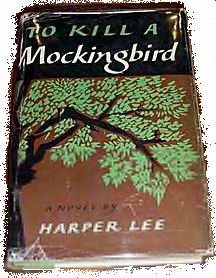





.jpg)







 The To Kill a Mockingbird Movie
The To Kill a Mockingbird Movie  Seckatary spinner - reads Fair & Square when spinning.
Seckatary spinner - reads Fair & Square when spinning.